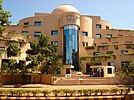Mangalore
| |
|---|---|
City | |
| Mangaluru | |
Mangalore CBD skyline | |
| Coordinates: 12°52′18″N 74°50′33″E / 12.87167°N 74.84250°E | |
| Country | |
| State | Karnataka |
| District | Dakshina Kannada |
| Taluk | Mangalore |
| Named for | Mangaladevi |
| Government | |
| • Type | Municipal Corporation |
| • Body | Mangalore City Corporation |
| • Mayor | Manoj Kumar[2] |
| Area | |
• Total | 170 km2 (70 sq mi) |
| Elevation | 22 m (72 ft) |
| Population (2021) | |
• Total | 724,159[1] |
| • Density | 4,250/km2 (11,000/sq mi) |
| Demonym | Mangalorean |
| Languages | |
| • Administrative | Kannada, English |
| Time zone | UTC+5:30 (IST) |
| PIN | 575001 to 575030 |
| Telephone code | +91-(0824) |
| Vehicle registration | KA-19, KA-62[4] |
| Sex ratio | 1.016[5] |
| Human Development Index | very high |
| Literacy | 94.03%[7] |
| Website | www |
Mangalore (/ˈmæŋɡəlɔːr, ˌmæŋɡəˈlɔːr/ MANG-gə-lor, -LOR), officially known as Mangaluru (Kannada: [mɐŋɡɐɭuːru]), is a major industrial port city in the Indian state of Karnataka and on the west coast of India. It is located between the Laccadive Sea and the Western Ghats about 352 km (219 mi) west of Bangalore, the state capital, 14 km north of Karnataka–Kerala border and 297 km south of Goa. Mangalore is the state's only city to have all four modes of transport—air, road, rail and sea. The population of the urban agglomeration was 619,664 according to the 2011[update] national census of India. It is known for being one of the locations of the Indian strategic petroleum reserves.
The city developed as a port in the Laccadive Sea during ancient times, and after Independence a new port was constructed in 1968 and has since become a major port of India that handles 75 percent of India's coffee and cashew exports. It is also the country's seventh largest container port. Mangalore has been ruled by several major powers, including the Mauryan empire, Kadambas, Alupas, Vijayanagar Empire, and Keladi Nayaks. The city was a source of contention between the British and the Kingdom of Mysore rulers Hyder Ali and Tipu Sultan, and was eventually annexed by the British in 1799. Mangalore remained part of the Madras Presidency until India's independence in 1947 and was unified with Mysore State (now called Karnataka) in 1956.
Mangalore is one of the fastest developing cities in India. The Dakshina Kannada district with its administrative headquarters at Mangalore has the highest Per Capita Income and Gross State Domestic Product in Karnataka, after Bangalore. Mangalore is a commercial, industrial, business, educational, healthcare, and startup hub. Mangalore City Corporation is responsible for the civic administration which manages the 60 wards of the city. Its landscape is characterised by rolling hills, coconut palms, rivers, and hard laterite soil.
Mangalore is included as one of the cities in the Smart Cities Mission list and is among the 100 smart cities to be developed in India. It has an average elevation of 22 m (72 ft) above mean sea level. It has a tropical monsoon climate and is under the influence of the southwest monsoon. It has its own International Airport which is around 15 km from the city centre.
- ^ "Population of cities in India 2021". Statistics Times. Retrieved 30 January 2023.
- ^ "BJP's Manoj Kumar and P.S. Bhanumathi elected new Mayor and Deputy Mayor of Mangaluru". The Hindu. 19 September 2024. Retrieved 25 October 2024.
- ^ "Mangaluru City Corporation". Mangaluru Smart City. Retrieved 7 July 2020.
- ^ Shenoy, Jaideep (16 February 2017). "Surathkal all set to get a new RTO in next 20 days". The Times of India. Retrieved 13 March 2020.
- ^ Kumar, T K Anil. "Primary census abstract data highlights" (PDF). censuskarnataka.gov.in. p. 69. Retrieved 5 March 2020.
- ^ Sastry, Anil Kumar (2 January 2016). "Human Development Index: DC exhorts officials to aim high". The Hindu. Retrieved 18 February 2016.
- ^ "Cities having population 1 lakh and above, Census 2011" (PDF). censusindia.gov.in. Retrieved 4 October 2015.
- ^ "Census of India - Language". censusindia.gov.in. Retrieved 7 May 2021.










